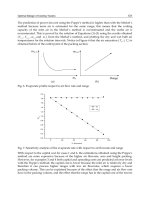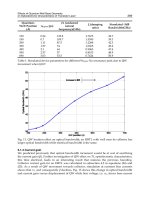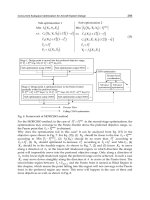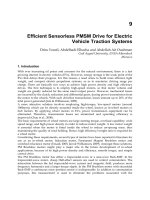Vital Signs and Resuscitation - part 8 pot
Bạn đang xem bản rút gọn của tài liệu. Xem và tải ngay bản đầy đủ của tài liệu tại đây (368.9 KB, 18 trang )
118 Vital Signs and Resuscitation
7
reflux and infantile botulism. Treatment: hospitalization for an apnea workup.
The infant is then sent home with an apnea monitor.
Upper Respiratory Emergencies
Obstruction (complete obstruction is discussed in Chapter 8)
Partial obstruction by a foreign body in the child may pose a problem
because the circumstance is often unwitnessed and signs may be confusing.
Choking, coughing and gagging may occur, then subside as the object passes
into a smaller airway, usually the right mainstem bronchus (the anatomical
Fig. 7.4. Pediatric Bradycardia Algorithm. Reprinted with permission from: Guide-
lines for 2000 for Cardiopulmonary Resuscitation and Emergency Cardiovascular
Care, American Heart Association.
119Pediatric Vitals
7
continuation of the trachea). This may later produce coughing, wheezing or
stridor in any combination (a foreign body in the upper esophagus causes
stridor, drooling and dysphagia). The diagnosis is made by a high index of
suspicion and various x-ray techniques, among them bilateral decubitus chest
x-rays. The normal chest shows decreased relative volume on the downside
compared to the upside. With obstruction on the downside, the downside
remains fully inflated. Treatment: laryngoscopy or bronchoscopy with re-
moval of the object in the operating room under anesthesia. Esophageal
foreign bodies are removed by endoscopic forceps (see also Chapter 8).
Croup
Croup, or laryngotracheobronchitis, is a viral infection (parainfluenza
virus) of the upper airway in the 6-month to 3-year-old population (most
under 1 year). Fever and a barking cough are present, mostly at night, often
accompanied by mild stridor, tachypnea and retractions. Treatment: hu-
midified oxygen (“mist wand”), racemic epinephrine 0.5 cc in 3 cc NS, pred-
nisolone (Prelone syrup) 1 mg/kg PO or dexamethazone (Decadron) 0.3
mg/kg PO or IM and PO fluids.
Epiglottitis
Epiglottitis is an infection of supraglottic tissue causing edema and par-
tial obstruction of the glottis (airway). The incidence has decreased because
of Hemophilus influenza vaccine. Other organisms are Strep and Staph. The
median age is 7. Symptoms are a sudden onset of fever, sore throat and
difficulty swallowing and talking (dysphonia). Stridor and drooling are of-
ten present, and the child sits with the chin forward. Treatment: because
obstruction of the upper airway may occur at any time, a portable neck xray
is taken in the emergency department, intubation equipment is assembled,
and the doctor remains with the patient at all times. If the x-ray confirms the
diagnosis, arrangements are made for immediate intubation by anesthesiol-
ogy in the operating room. The child remains seated, and no blood is drawn
or other treatments begun. If the child is seen in a doctor’s office, a physician
able to intubate should accompany the child to the hospital. After the air-
way is secured, cultures are taken and antibiotics are administered (i.e.,
ceftriaxone 50 mg/kg every 24 hours).
Lower Respiratory Emergencies
Asthma
Asthma, discussed in Chapter 4, is an allergic reaction precipitated by
irritants, stress and infection. Mast cells release histamine and other media-
tors which cause bronchoconstriction, followed by airway edema. Signs and
symptoms include shortness of breath, cough, wheezing and tachypnea.
Evaluation is by means of pulse oximetry, peak flow, and blood gases.
120 Vital Signs and Resuscitation
7
Treatment: oxygen is placed if the O
2
saturation is <94%, a beta-agonist
such as albuterol 2.5 mg in 2 cc NS is administered by nebulizer over an
hour, and prednisolone (Prelone syrup) 1 mg/kg is given orally.
The need for close observation is indicated with a history of frequent
hospitalizations, a previous intubation, use of steroids, an oxygen saturation
<94% and a peak flow less than 10% improvement after several nebulizer
treatments. An oxygen saturation less than 90% mandates ABGs. A CO
2
of
>50 mmHg indicates impending respiratory failure. Signs of respiratory dis-
tress are nasal flaring, retractions, agitation, lethargy, confusion, sweat-
ing, altered consciousness and grunting (see Pediatric Respiratory Failure,
Chapter 8).
Bronchiolitis
Bronchiolitis is similar to asthma except that the cause is a virus (usually
respiratory syncytial virus—RSV) causing an inflammation of the bronchi-
oles. It is seen in a younger age group (under 2 years of age) than the asthmatic.
Fever, wheezing and tachypnea are present. Evaluation is by oxygen satura-
tion and ABGs. Nasal washings may identify RSV. Treatment: nebulized
racemic epinephrine (as for croup) is administered. Steroids are not used.
PO or IV hydration is helpful. Pulse oximetry showing an oxygen saturation
of 91% or below and/or sustained tachypnea (respiratory rate of 60 or greater)
indicates the need for admission.
Blood Pressure
Blood pressure is measured by auscultation, palpation, Doppler or an
oscillometric instrument such as the Dinamap. The blood pressure cuff should
be long enough to encircle the arm completely, with slight overlap. The
width should be about 2/3 the length of the arm. The lower limit of normal
blood pressure in a child may be estimated by the formula: 70 + (2 x the age
in years). Example: a three year old should have a systolic pressure above 76
mm Hg (Fig. 7.5).
Shock
Hypovolemic Shock
Hypovolemic shock from dehydration caused by gastroenteritis is an
important cause of shock in the pediatric age group. Hypovolemic shock
may also be caused by blood loss from trauma. Dehydration is seen after
continuous vomiting and/or diarrhea and by decreased fluid intake over sev-
eral days. Signs and symptoms include tachycardia, tachypnea, decreased
urinary output, altered mental status and dry mucous membranes (see Fig.
7.6). It is important to note that only in the final stages of shock does the
blood pressure fall. Tachycardia is prevalent throughout all stages. The child
is positively orthostatic if an increase in heart rate (>25 beats per minute
121Pediatric Vitals
7
rather than 30 as in the adult) or near-syncope occurs (see Chapter 5 Ortho-
static Vital Signs, and Fig. 5.6). A good early indicator of shock in infants is
capillary refill, discussed in Chapter 5. The fingernail bed is gently pressed
and the time noted for the blanched nailbed to return to normal. Normal is
less than 2 seconds. 2-3 seconds represents 5-10% dehydration. Longer than
3 seconds represents a greater than 10% deficit. Treatment for dehydration:
1. The ABCs of resuscitation are followed;
2. Normal saline 20 cc/kg IV bolus x 2 is administered; then
3. D5.25NS IV as maintenance, plus extra fluid to compensate for
hypovolemia (Fig. 7.7) and
4. Fluids are adjusted so that the urine output is maintained at
1 ml/kg/hour.
Hypovolemic shock from blood loss: signs and symptoms are similar
to those in dehydration. Treatment: the ABCs of resuscitation are followed,
NS 20 cc/kg IV bolus x 2 is administered, the urine output is maintained at
1 cc/kg per hour, 10 cc/kg of type-specific warmed packed red blood cells
Fig. 7.5. Pediatric Blood-Pressure Cuffs.
Fig. 7.6. Pediatric Dehydration.
122 Vital Signs and Resuscitation
7
(or O-negative RBCs if the need is urgent) is given, and a surgical consult is
obtained as soon as possible (Figs. 7.6, 7.7).
Septic Shock
Septic shock is the last stage of a continuum from sepsis (see Fever, this
Chapter, and Septic Shock, Chapter 5). Signs and symptoms include irrita-
bility, poor feeding and lethargy. Fever is present in the early stage, accompa-
nied by tachycardia, tachypnea and warm and pink extremities. In later stages,
inflammatory mediators are activated, pulses are weak, extremities are cool,
mental status is decreased, capillary refill is prolonged, hypothermia may be
present and the pulse pressure widens (hypotension is not seen until late,
unlike the adult). The WBC may be high or low. Cultures are done on
blood, urine and cerebrospinal fluid. Treatment:
1. The ABCs of resuscitation are followed;
2. 20 cc/kg boluses of IV NS are administered to maintain a urine
output of 1 cc/kg per hour;
Fig. 7.7. Pediatric Fluid Resuscitation.
123Pediatric Vitals
7
3. If BP can not be maintained, dopamine 5 ug/kg/min is added and
4. For the neonate, cefotaxime (Claforan) is given 50 mg/kg IV every
6 hours, plus ampicillin 50 mg/kg every 6 hours. For the infant
and child, ceftriaxone (Rocephin) is administered at 50 mg/kg IV
every 12 hours. Antibiotics should be administered when blood
cultures are drawn, before the lumbar puncture.
Anaphylactic shock is discussed in Chapter 5.
Level of Consciousness
Basic features of decreased level of consciousness are discussed in Chap-
ter 6. In contrast to the adult, the more common causes of decreased mental
status in pediatrics are meningitis, poisoning and head trauma (common
causes in adults are alcohol and drug abuse, hypoglycemia and hemorrhagic
stroke). Drug ingestion has emerged as an important factor in the pediatric
population. Although the Glasgow Coma Scale is useful for an older pediat-
ric population, the “verbal response” section of the scale was restructured for
children under 4 years of age. Recently a further modification was made for
infants ages 0-23 months. Score totals are the same as for the adult. The
Pediatric Glasgow Coma Scale has also been incorporated into the Re-
vised Trauma Score. Steps in management are the ABC’s, the administra-
tion of naloxone and glucose (if there is difficulty obtaining a blood sugar)
and a low threshold should be present for lumbar puncture and head CT
scanning (see Fig. 6.4). Increased intracranial pressure is treated without
delay (Fig. 6.5). As with the adult, lab tests may be helpful, including an
ammonia and toxicological studies. An important difference from the adult
is that the history is usually easier to obtain (from parents—medical history,
possible drug ingestion, trauma). The mnemonics TIPS and AEIOU are still
useful (Fig. 6.9).
Common Causes of Pediatric Coma: TIPS, AEIOU (see
also Chapter 6)
Trauma, Temperature: see also Chapters 2 and 8
Infection
An important cause of coma is meningitis from bacteremic invasion of
the brain, causing inflammation and increased intracranial pressure. Two-
thirds of all cases of meningitis are in pediatrics, most cases occurring be-
tween birth and age 2. Strep pneumoniae and N. meningitidis are the usual
pathogens because of the recent use of Hemophylus influenzae type b (Hib)
vaccine. A common presentation is fever accompanied by an altered mental
state. Infants may show poor feeding, vomiting, paradoxical irritability
(explained in the Fever section) and have a bulging fontanelle. Seizures are
124 Vital Signs and Resuscitation
7
present in 25% of cases. A petechial rash is present in meningococcemia.
Other signs and symptoms are listed in the Fever and Septic Shock sections.
In older children, fever, headache and photophobia are commonly present
(see Chapter 6). Treatment: as for Septic Shock.
Shock, Seizures: See earlier sections
Alcohol/Drugs
As mentioned in Chapter 6, it is not appropriate to list the multitude of
drugs and toxins that may cause a decreased level of consciousness. Alcohol
Fig. 7.8. Pediatric Glasgow Coma Scale.
125Pediatric Vitals
7
ingestion and intoxication is prevalent in the teenage population. Inten-
tional and inadvertent drug ingestion is rising. Treatment: alcohol problems
are discussed in Chapter 6. To prevent further absorption of ingested seda-
tives/hypnotics or opiates, activated charcoal (1 gm/kg) is administered by
nasogastric tube (12-16 French). If no gag reflex is present, the patient is first
intubated (rapid sequence intubation may be required—see Chapter 8).
Endocrine, Electrolytes: hypernatremia and hyponatremia (Na: <120
meq/l) cause weakness and decreased level of consciousness. Hypovolemic
hypernatremia (from dehydration) is a common cause of hypernatremia and
Fig. 7.9. Pediatric Revised Trauma Score.
126 Vital Signs and Resuscitation
7
is treated with IV normal saline infusion. The fluid is changed to 0.5 NS
when the urine output is 0.5 ml/kg/hr. Hyponatremia depends on the cause.
If it is an excess of water, the treatment is water restriction. If it is because of
Na loss, isotonic saline is administered.
Insulin: poorly controlled or new-onset diabetes mellitus is an impor-
tant cause of decreased level of consciousness in pediatrics. Kussmaul breathing
is frequently seen in diabetic ketoacidosis (see Chapter 6). Hypoglycemia
(blood glucose <40 mg/dL) is rare, and is usually the result of poorly con-
trolled insulin therapy or is idiopathic. Treatment: for hypoglycemia, glu-
cose is administered as a 3 ml/kg IV bolus of D10W. For ketoacidosis,
intravenous normal saline is infused at 20 ml/kg over 2 hours, and insulin is
given at 0.1 unit/kg/hr. 40 meq of K+ is added to each liter of fluid.
Oxygen: see Chapter 8.
Uremia: see Chapter 6.
Practical Points
•First, the ABCs of resuscitation are followed (see Chapter 8).
•Pediatric arrests are usually respiratory.
• Children under 2 months of age with a temperature over 100.4 F
(38˚C) will usually require a septic workup, including lumbar
puncture.
•Dehydration is a critical condition. Prolonged capillary refill and ta-
chycardia are important signs of shock.
•Venous access in an infant is a problem for everyone. When necessary
it must be done.
References
1. American Academy of Pediatrics/American College of Emergency Physicians. Advanced
pediatric life support, 3rd Ed. Dallas, 1998.
2. American Academy of Pediatrics. Textbook of Pediatric advanced life support. Dallas:
American Heart Association, 1997.
3. American College of Emergency Physicians (ACEP). Clinical policy for the initial
approach to children under the age of 2 years presenting with fever. Ann Emerg Med
1993; 22:628.
4. American College of Surgeons: Pediatric trauma. In: Advanced Trauma Life Support.
Chicago, 1997.
5. Apgar V. A proposal for a new method of evaluation of the newborn infant. Curr
Research Anesth July-Aug 1953.
6. Apgar V et al. Evaluation of the newborn infant—Second report. JAMA 1958; 168:15.
7. Baker M. Evaluation and management of infants with fever. Ped Clin N Am 1999;
46:1061.
8. Baraff L. Management of fever without source in infants and children. Ann Em Med
2000; 36:602.
9. Barkin R, Rosen P. Emergency Pediatrics. St. Louis: CV Mosby Co., 1999.
10. Biehler J, Barnes B. Evaluation of vital signs. In: Henretig F et al. Textbook of Pediat-
ric Emergency Procedures. Baltimore: Williams & Wilkins, 1997.
127Pediatric Vitals
7
11. Bonadio W et al. Clinical characteristics of children with fever and transient neutro-
penia who experience serious bacterial infection. Ped Em Care 1989; 5:163.
12. Bulloch B, Ruddy M. Asthma update: Managing asthma in the pediatric emergency
department. Em Med Rep 1998; 3:39.
13. Catalina P. Occult bacteremia in toddlers: Watch or treat? Em Med 1992; 24:67.
14. Catlin E et al. The APGAR score revisited: Influence of gestational age. J Pediatrics
1986; 109:5.
15. Cordle R, Relich N. Pediatrics: Upper respiratory emergencies. In: Tintinalli J et al.
Emergency Medicine: A Comprehensive Study Guide. New York: McGraw-Hill, 2000.
16. Gjerris F. Head injuries in children—Special features. Acta Neurochi Suppl 1986;
36:155.
17. Gorelick M, Baker D. Epiglottitis in children, 1979 through 1992. Arch Pediatr Adolesc
Med 1994; 148:47.
18. Haddock B et al. Axillary and rectal temperatures of full-term neonates: Are they
different? Neonatal Network Aug, 1986.
19. Klassen T. Croup: A current perspective. Ped Clin N Am 1999; 46:1167.
20. Kuppermann N. Occult bacteremia in young febrile children. Ped Clin N Am 1999;
46:1073.
21. Landau L, Geelhoed G. Aerosolized steroids for croup. N Eng J Med 1994; 331:5.
22. Lewitt E et al. An evaluation of a plastic strip thermometer. JAMA 1982; 247:321.
23. Lieh-Lai M et al. Limitations of the Glasgow Coma Scale in predicting outcome in
children with traumatic brain injury. J Ped 1992; 120:195.
24. Mace S. Issues in pediatric emergency medicine. Foresight 1999; 47:1.
25. McCarthy Paul. Infants with fever. NEJM 1993; 329:1494.
26. Morley C et al. Symptoms and signs in infants younger than 6 months of age corre-
lated with the severity of their illness. Pediatrics 1991; 88:1119.
27. Nizet V et al. Fever in children. Ped Review 1994; 15:127.
28. Park M et al. Direct blood pressure measurements in brachial and femoral arteries in
children. Circ Feb 1970:41.
29. Pidwell W et al. Accuracy of the temporal artery thermometer. Ann Em Med Suppl
2000; 36:5.
30. Ramenofsky M et al. Maximum survival in pediatric trauma: The ideal system. J
Trauma 1984; 24:9.
31. Ramenofsky M et al. The predictive validity of the pediatric trauma score. J Trauma
1987; 27:7.
32. Rothrock S et al. Diagnosis of epiglottitis: Objective criteria for all ages. Ann Emerg
Med 1990; 19:978.
33. Rothrock S, Perkin R. Stridor: A review, update, and current management recom-
mendations. Em Med Rep 1996; 1:29.
34. Smith S, Strunk R. Acute asthma in the pediatric emergency department. Ped Clin N
Am 1999; 46:1145.
35. Sofer S, Benkovich E. Severe infantile hypothermia: Short and long term outcome.
Intens Care Med 2000; 26:88.
36. Supure J. Hyperpyrexia in children: Clinical implications. Ped Em Care 1987; 3:10.
37. Talan D et al. Analysis of emergency department management of suspected bacterial
meningitis. Ann Em Med 1989; 18:856.
38. Thomson A et al. Validation of the Glasgow Meningococcal Septicemia Prognostic
Score: A ten-year retrospective survey. Crit Care Med 1991; 19:26.
128 Vital Signs and Resuscitation
8
CHAPTER 8
Resuscitation
Adult Resuscitation
Resuscitation has become a ubiquitous term meaning not only cardiop-
ulmonary arrest, but also prearrest conditions such as respiratory distress,
stridor, coma, drug overdoses and some bradycardias and tachycardias. Ex-
cluding the hospitalized patient, the reason for the arrest is usually unknown
and the only information is the rhythm on the monitor and tenuous vital
signs. Thus, protocols involving therapies for specific conditions are often
not helpful. In this book, the majority of prearrest conditions are discussed
in the appropriate vital sign chapter. When vital signs are lost, basic resusci-
tation begins immediately (Basic Life Support) by any bystander (“lay res-
cuer” in the literature). When emergency medical services (EMS) arrives,
Basic Life Support is supplemented with equipment and therapeutic mo-
dalities (Advanced Life Support. EMS and hospital personnel are “healthcare
providers”). NOTE: 2000 BLS guidelines indicate that since the average
person may have difficulty assessing a pulse, the pulse check is eliminated
for the lay rescuer but applies to the healthcare provider.
Basic Life Support (BLS)
1. Establish unresponsiveness. Shake the person. “Are you okay?” If
no response,
2. Activate EMS system, or if in hospital call for appropriate help.
3. AIRWAY. Open airway using jaw thrust or chin lift. If trauma sus-
pected, stabilize neck, use jaw thrust.
4. BREATHING. Look, listen and feel for breathing. If inadequate
or no breathing, 2 slow breaths mouth to mouth (nose closed), or
use pocket mask or bag-valve mask, 12 breaths per minute.
5. CIRCULATION. If breathing, airway support as above. If no
breathing (or no pulse by healthcare provider), begin chest com-
pressions lower sternum, heel of hand (other hand on top), 2 inches
deep, 100 per minute. 15 compressions and 2 ventilations for 1 or
2 rescuers (compression/ventilation ratio 15:2.
Advanced Life Support (ALS)
1. Assess responsiveness, if none,
Vital Signs and Resuscitation, by Joseph V. Stewart. ©2003 Landes Bioscience.
129Resuscitation
8
Fig. 8.1. Summary of Basic Life Support (BLS) Protocols (continued below). Reprinted with permission from: Guidelines for
2000 for Cardiopulmonary Resuscitation and Emergency Cardiovascular Care, American Heart Association.
130 Vital Signs and Resuscitation
8
131Resuscitation
8
2. Outside hospital—activate EMS system.
Inside hospital—call for defibrillator, or if on monitor and
defribillator present and V-fib or pulseless V-tach defibrillate x 3
(200, 300 , 360 joules).
3. Open AIRWAY and assess BREATHING. If none, 2 slow breaths
(in trauma, maintain cervical spine immobilization).
4. Assess PULSE. If present, mouth-to-mouth or bag-valve-mask or
intubation at 12 breaths per minute (plus needle thoracentesis or
chest tube if needed). If no pulse,
5. CPR: chest compressions 100 per minute. Compression/ventila-
tion for 1 to 2 rescuers (15:2), with intubated patient 2 providers
(5:1).
6. When DEFIBRILLATOR arrives and shows VF/pVT, defibril-
late x 3. If another rhythm, continue CPR, intubate, IV access,
determine rhythm and therapy.
7. DISABILITY: if adequate pulse and respirations, but comatose,
use Coma Protocol (Fig. 6.4).
Fig. 8.2. Jaw Thrust.
132 Vital Signs and Resuscitation
8
1. AIRWAY:
Airway control is the critical first step in resuscitation. The head is tilted
and either the jaw thrust or chin lift used to open the airway. Protection of
the airway may require endotracheal intubation, often needed with respira-
tory distress and hypoventilation from any cause. It is also needed to prevent
aspiration in the comatose patient or the patient with decreased level of
consciousness and no gag reflex. The patient is ventilated with 100% oxygen
using two assistants and a bag-valve-mask. Insertion of an endotracheal tube
is performed orally (orotracheal intubation) or nasally (nasotracheal intu-
bation). Nasotracheal intubation is performed only on the breathing pa-
tient. It is useful in the immobilized patient, when the patient has clenched
teeth or when cooperation is needed (i.e., the asthmatic or the patient with
pulmonary edema). It is contraindicated with maxillofacial injuries or a basilar
skull fracture.
Trauma
In the trauma patient, the C-spine is protected with a cervical collar and
the jaw thrust is used. The oral cavity is inspected for foreign bodies, vomi-
tus, broken teeth and suctioned using a hard-tipped suction catheter.
Examination of the neck and intubation in the trauma patient requires in-
line immobilization by an assistant in order to stabilize the neck when the
cervical collar is removed (Fig. 8.3).
Rapid Sequence Intubation
Intubation is sometimes necessary for an awake patient. The criterion is
deterioration of vital signs so that the airway will be unprotected. Examples:
head injury, a combative or agitated patient, a patient with clenched teeth,
Fig. 8.3. Intubation with In-line Immobilization.
133Resuscitation
8
respiratory failure, impending cardiovascular collapse and a diminishing level
of consciousness from any cause. Rapid sequence intubation (RSI) is per-
formed using the following or a similar protocol:
1. Oxygen by nonrebreather mask for 5 minutes.
2. Induction with IV thiopental (Pentothal) 4 mg/kg or etomidate
(Amidate) 0.3 mg/kg. Lidocaine 1 mg/kg IV is added to blunt the
rise in intracranial pressure in head injuries.
3. An assistant applies pressure to the cricoid cartilage to occlude the
esophagus and prevent esophageal reflux and aspiration (Sellick
maneuver).
4. Paralysis with IV succinylcholine (Anectine) 1.5 mg/kg, or
rocuronium (Zemuron) 1 mg/kg.
5. The tube is passed through the vocal cords (intubation).
6. Cricoid pressure is released.
7. Bag, listen for breath sounds, pulse ox/CO2 indicator.
8. X-ray for tube placement.
Surgical Airway
If intubation is not possible, a tracheostomy tube with an inflatable cuff
(i.e., #6 Shiley), or a #6 or 7 endotracheal tube, is inserted through the
cricothyroid membrane between the thyroid (“Adam’s apple”) and cricoid
cartilages (cricothyrotomy). The patient is bagged through the ET or tra-
cheostomy tube. If a tracheostomy tube is not available, a 14g angiocath may
be inserted through the cricothyroid membrane (needle cricothyrotomy) while
preparing for a surgical airway (Fig. 8.4).
Fig. 8.4. Cricothyrotomy.
134 Vital Signs and Resuscitation
8
Choking
Choking from a foreign-body does not occur in the emergency depart-
ment, but often takes place in a restaurant (“cafe coronary”). The person is
drinking, the throat muscles are relaxed, he is talking while eating and inhales
at the same time he is swallowing. The piece of food, usually meat, impacts
against the vocal cords, obstructing breathing. The person grasps his neck
with the thumb and fingers, a universally recognized sign of airway obstruc-
tion. The first thing to do is to ask if he can speak. If he can, he is not
obstructed. If he cannot, he is. Partial obstruction may occur, in which case
coughing and stridor are present, but the person is exchanging air. Treat-
ment for obstruction is as follows (Fig. 8.5):
1. The abdominal thrust (Heimlich maneuver) creates intrathoracic
pressure and will expel almost any foreign body. The thumb side of
the fist is placed against the person’s abdomen, slightly above the
navel. The fist is grasped with the other hand and pressed upward
quickly and forcefully as many times as needed to dislodge the object.
2. If the person becomes unconscious, he is placed on his back on the
floor. With one hand on top of the other, abdominal thrusts are per-
formed by the rescuer with the palms of the hands pushing upward.
3. Since hypoxic brain damage occurs in 7-10 minutes, after sev-
eral failed attempts at abdominal thrusts the rescuer should
open the mouth and perform finger sweeps. After this, rescue
breathing should be attempted.
Fig. 8.5. Abdominal Thrust (Heimlich Maneuver).
135Resuscitation
8
4. If attempts at abdominal thrusts, finger sweeps and rescue breath-
ing are unsuccessful and the 7 minute point is approaching, an
emergency cricothyrotomy may be life-saving: thrust anything,
such as a knife or ballpoint pen, into the indentation between the
thyroid and cricoid cartilages (cricothyroid membrane). The force
must be substantial or the trachea will not be penetrated. Remove
the inner pen piece and keep the barrel in place, or keep the space
open with two keys, or 2 to 3 straws. Stay with the person until
paramedics arrive.
5. The Heimlich maneuver may be performed on oneself, as in 1.
Tr eatment for partial obstruction: remain with the person until he is trans-
ported to the nearest emergency facility, since complete obstruction may
occur at any time.
Fig. 8.6. Emergency Cricothyrotomy.









